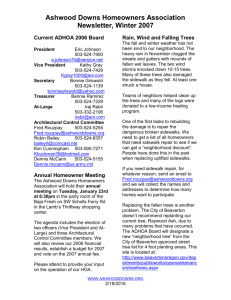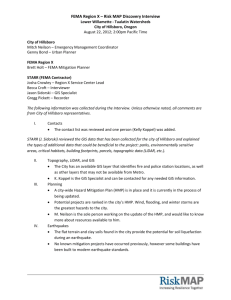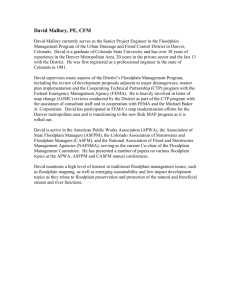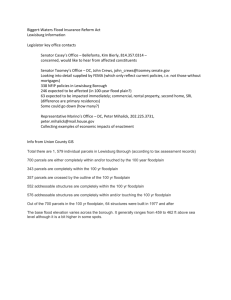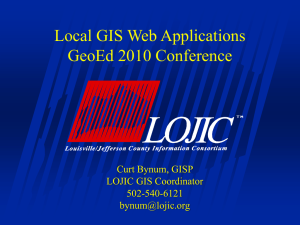FOR FEMA AND STATE REVIEW-MeetingMinutes
advertisement
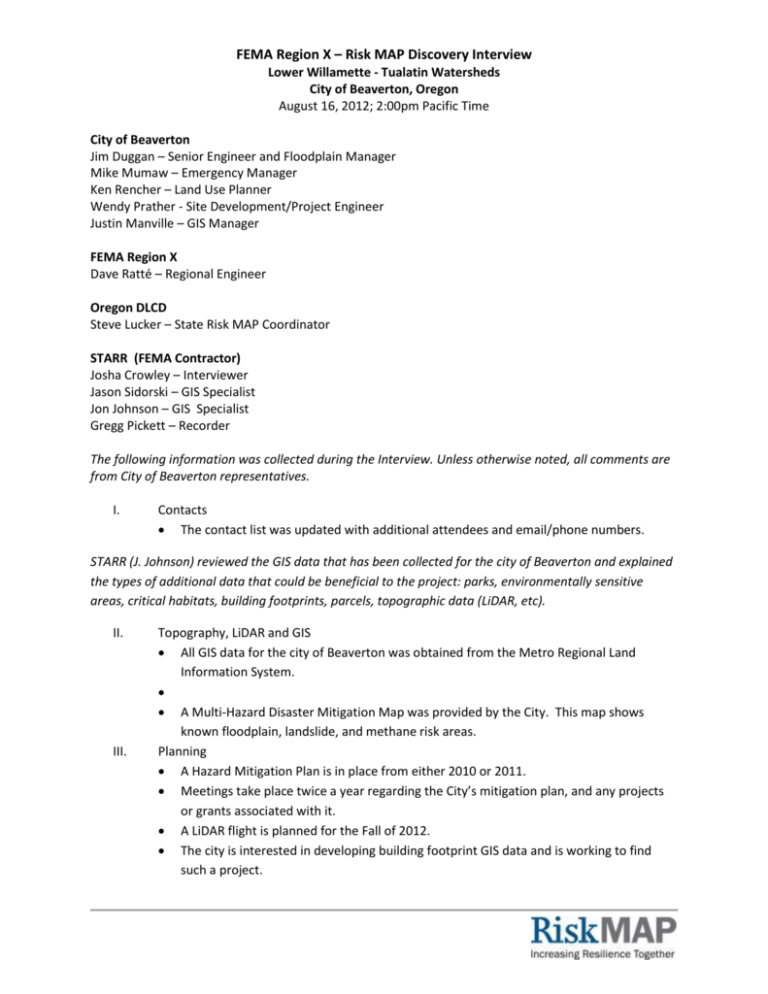
FEMA Region X – Risk MAP Discovery Interview Lower Willamette - Tualatin Watersheds City of Beaverton, Oregon August 16, 2012; 2:00pm Pacific Time City of Beaverton Jim Duggan – Senior Engineer and Floodplain Manager Mike Mumaw – Emergency Manager Ken Rencher – Land Use Planner Wendy Prather - Site Development/Project Engineer Justin Manville – GIS Manager FEMA Region X Dave Ratté – Regional Engineer Oregon DLCD Steve Lucker – State Risk MAP Coordinator STARR (FEMA Contractor) Josha Crowley – Interviewer Jason Sidorski – GIS Specialist Jon Johnson – GIS Specialist Gregg Pickett – Recorder The following information was collected during the Interview. Unless otherwise noted, all comments are from City of Beaverton representatives. I. Contacts The contact list was updated with additional attendees and email/phone numbers. STARR (J. Johnson) reviewed the GIS data that has been collected for the city of Beaverton and explained the types of additional data that could be beneficial to the project: parks, environmentally sensitive areas, critical habitats, building footprints, parcels, topographic data (LiDAR, etc). II. III. Topography, LiDAR and GIS All GIS data for the city of Beaverton was obtained from the Metro Regional Land Information System. A Multi-Hazard Disaster Mitigation Map was provided by the City. This map shows known floodplain, landslide, and methane risk areas. Planning A Hazard Mitigation Plan is in place from either 2010 or 2011. Meetings take place twice a year regarding the City’s mitigation plan, and any projects or grants associated with it. A LiDAR flight is planned for the Fall of 2012. The city is interested in developing building footprint GIS data and is working to find such a project. Risk MAP Discovery Interview – Lower Willamette - Tualatin Watersheds City of Beaverton – August 16, 2012 IV. V. VI. VII. Page 2 of 4 City Hall was recently seismically-upgraded/retrofitted using a pre-hazard mitigation grant. Undeveloped areas located in a mapped floodplain cannot be sub-divided in the city. Stream protection requirements sometimes go beyond what is shown as the floodplain. All development in the downtown district requires a higher freeboard than minimum standards because of the known flood risk. Earthquakes Several earthquake faults are located in Beaverton. A long duration earthquake is a known risk in the city, this could cause landslides, soil liquefaction, and structural damage. The Nisqually Quake (2001) in Washington caused structural damage to multiple buildings within the city. The City Hall retrofit is the only mitigation action that has taken place regarding earthquakes in Beaverton. Wildfires A few large park areas exist, but overall wildfire risk is minimal. The Tualatin Valley Fire and Rescue has a plan in place to address the known risk. Landslides Properties with slopes of more than 25% are heavily regulated using existing ordinances. The geology of these areas must be studied and construction design approved before any permits are issued. A map of the areas of historic landslides was provided to the City by DOGAMI. This data was developed using LiDAR data. Naturally-occurring methane gas is a concern for the City due to development on an old landfill. Two roadways have potential to be damaged by landslides, but there are alternate routes available if that were to occur. Severe Storms High winds and high rainfall amounts are the most likely cause of storm damage in the city of Beaverton. Occasional heavy snow occurs. Power outages usually last no longer than one day, although historically longer outages have occurred. In 1979 and 1980, long-duration outages occurred, prompting utilities to put their transmission lines underground. Having the utilities underground has largely eliminated any long term power outages, and has also improved the aesthetics of the area. The Red Cross has emergency shelter locations identified, but these locations are not given to the public until an emergency is imminent. The State of Oregon has recently updated this list, and the data has been obtained from Metro. Citizens monitor local media and the National Weather Service for emergency information, along with the City website, email, and social media. Risk MAP Discovery Interview – Lower Willamette - Tualatin Watersheds City of Beaverton – August 16, 2012 VIII. IX. X. Page 3 of 4 Flooding The City has concerns about the flood risk shown on the preliminary Washington County FIRMs. A local consultant prepared products that the city believes are of a much higher quality than what ended up on the preliminary FIRMs. The City would prefer to use this data for their floodplain management purposes. The City believes that Washington County (U.A.) has a much bigger problem than Beaverton does regarding the preliminary FIRMs. The City tries to help people with their floodplain issues, even those living in the county with a Beaverton address. D. Ratté confirmed that FEMA is working with Washington County to try to get the flood mapping project back on track. The ongoing restudy superceded some floodplain revisions completed by a LOMR when light rail was constructed in the 1990’s. Much of the city was regulated based on the data from the LOMR, which is soon to be out-dated. A mobile home/manufactured home park is a major concern. It is often flooded. This is a highly contentious area. Further discussion flooding is desired at the upcoming Discovery meetings. The City is relatively happy with the current mapping and what it shows, but they feel that determination companies and lending institutions are not properly using that data in regard to the purchase of flood insurance. The City would be willing to adopt the new maps “as-is”. The new LiDAR being flown in the Fall of 2012 will cover all of the known problem areas currently existing on the FIRMs. Land acquisition and buffers are planned. S. Lucker requested that the City determine the cost of the building footprint data that they are hoping to acquire funding for, and to have that information at the upcoming Discovery meetings. The City is concerned how this Discovery project (and subsequent projects) would tie-in with the data being used for “Virtual USA”. They expressed concern about potentially having to use two sets of data, which might conflict with each other. S. Lucker told them that this issue is being looked into, and that it was hoped that each database would eventually draw from the same datasets. S. Lucker told the City that all data gathered during the Discovery process will be available to the City for their use. Levees No levees or flood protection measures are located in the City of Beaverton, but there are some storm bypasses located within the City. Environmentally Sensitive Areas Most environmentally sensitive areas overlap the floodplain boundaries, but no separate layers or databases exist for the City, other than what the DEQ maintains. Risk MAP Discovery Interview – Lower Willamette - Tualatin Watersheds City of Beaverton – August 16, 2012 XI. XII. Page 4 of 4 The Viewmaster Corporation dumped contaminants into the groundwater years ago, but this problem has now largely been resolved. New wetlands delineations have been completed by the City, largely because the definition of wetlands has changed since the original wetland inventory took place. Communications and Outreach The City sends periodic reminders about the availability of flood insurance to residents, particularly those at risk from flooding. A City newsletter talks about emergencies and having an emergency preparedness kit. Information is also sent out with water bills. Some information and materials are distributed to neighborhood associations, at the farmers market, at the county fair, at public libraries, etc. Historical landslide information is also distributed to potentially affected property owners. The floodplain permitting process is part of the normal permitting process. The City gets the Region X and STARR newsletter. Other Beaverton is a Washington County community, and Washington County FIRMs are currently in the process of being updated. City would like to hear more about the Multiple Hazard Risk Mapping initiative. Three annexation requests are currently underway in Beaverton. The City limtis can change frequently. Mobile home park owner (Jack) would like a visit from someone from FEMA when the Discovery meetings take place in late September.
